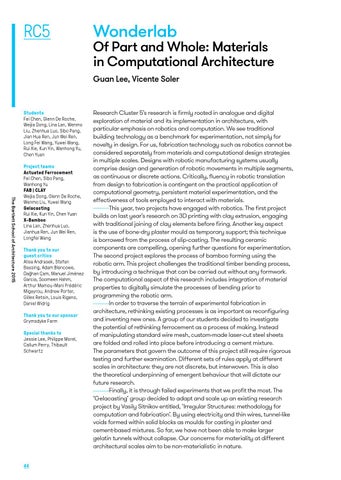RC5
Wonderlab
Of Part and Whole: Materials in Computational Architecture Guan Lee, Vicente Soler
Students Fei Chen, Glenn De Roche, Weijia Dong, Lina Lan, Wenmo Liu, Zhenhua Luo, Sibo Pang, Jian Hua Ren, Jun Wei Ren, Long Fei Wang, Yuwei Wang, Rui Xie, Kun Yin, Wanhong Yu, Chen Yuan
The Bartlett School of Architecture 2015
Project teams Actuated Ferrocement Fei Chen, Sibo Pang, Wanhong Yu FAB | CLAY Weijia Dong, Glenn De Roche, Wenmo Liu, Yuwei Wang Gelacasting Rui Xie, Kun Yin, Chen Yuan X-Bamboo Lina Lan, Zhenhua Luo, Jianhua Ren, Jun Wei Ren, Longfei Wang Thank you to our guest critics Alisa Andrasek, Stefan Bassing, Adam Blencowe, Dağhan Çam, Manuel Jiménez Garcia, Soomeen Hahm, Arthur Mamou-Mani Frédéric Migayrou, Andrew Porter, Gilles Retsin, Louis Rigano, Daniel Widrig Thank you to our sponsor Grymsdyke Farm Special thanks to Jessie Lee, Philippe Morel, Callum Perry, Thibault Schwartz
44
Research Cluster 5’s research is firmly rooted in analogue and digital exploration of material and its implementation in architecture, with particular emphasis on robotics and computation. We see traditional building technology as a benchmark for experimentation, not simply for novelty in design. For us, fabrication technology such as robotics cannot be considered separately from materials and computational design strategies in multiple scales. Designs with robotic manufacturing systems usually comprise design and generation of robotic movements in multiple segments, as continuous or discrete actions. Critically, fluency in robotic translation from design to fabrication is contingent on the practical application of computational geometry, persistent material experimentation, and the effectiveness of tools employed to interact with materials. This year, two projects have engaged with robotics. The first project builds on last year’s research on 3D printing with clay extrusion, engaging with traditional joining of clay elements before firing. Another key aspect is the use of bone-dry plaster mould as temporary support; this technique is borrowed from the process of slip-casting. The resulting ceramic components are compelling, opening further questions for experimentation. The second project explores the process of bamboo forming using the robotic arm. This project challenges the traditional timber bending process, by introducing a technique that can be carried out without any formwork. The computational aspect of this research includes integration of material properties to digitally simulate the processes of bending prior to programming the robotic arm. In order to traverse the terrain of experimental fabrication in architecture, rethinking existing processes is as important as reconfiguring and inventing new ones. A group of our students decided to investigate the potential of rethinking ferrocement as a process of making. Instead of manipulating standard wire mesh, custom-made laser-cut steel sheets are folded and rolled into place before introducing a cement mixture. The parameters that govern the outcome of this project still require rigorous testing and further examination. Different sets of rules apply at different scales in architecture: they are not discrete, but interwoven. This is also the theoretical underpinning of emergent behaviour that will dictate our future research. Finally, it is through failed experiments that we profit the most. The ‘Gelacasting’ group decided to adapt and scale up an existing research project by Vasily Sitnikov entitled, ‘Irregular Structures: methodology for computation and fabrication’. By using electricity and thin wires, tunnel-like voids formed within solid blocks as moulds for casting in plaster and cement-based mixtures. So far, we have not been able to make larger gelatin tunnels without collapse. Our concerns for materiality at different architectural scales aim to be non-materialistic in nature.
